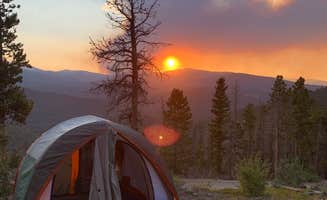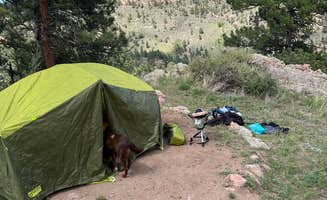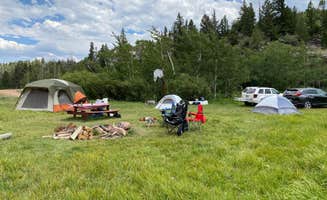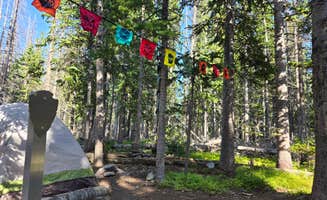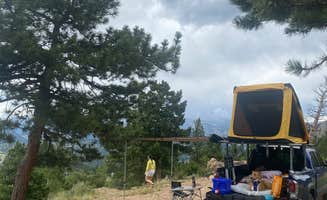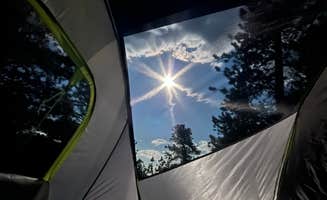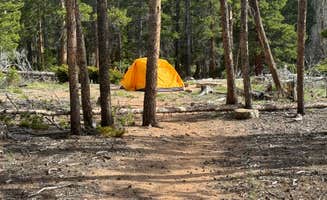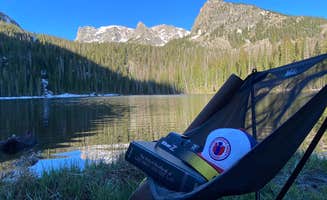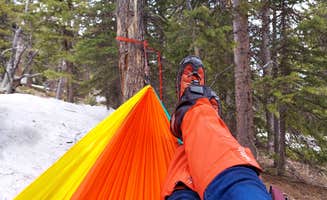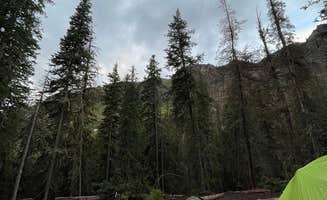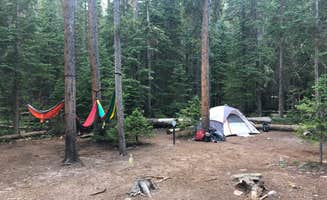Tent camping near Livermore, Colorado offers sites at elevations between 5,600 and 8,500 feet, with summer temperatures averaging 75-85°F days and 45-55°F nights. Most dispersed sites in this area require campers to travel on unpaved Forest Service roads with varying degrees of accessibility depending on recent weather conditions. Late summer brings frequent afternoon thunderstorms that can create hazardous flash flood conditions in creek-side camping areas.
What to do
Hike from your campsite: The Backcountry Campground at Horsetooth Mountain Open Space connects directly to the Horsetooth Rock trail. "This backcountry site is a hidden gem just off of the commonly used Horsetooth Rock trail. Awesome panoramic views and plenty of wildlife," notes Isabelle K. The trail to the campsite is only about 1.5 miles from the parking area.
Creek exploration: Dispersed camping areas along the Allenspark Dispersed Camping spots provide creek access during summer months. "A lot of good spots to pull off and relax for the night with a nearby stream," explains Mason M. Most sites are located within 30-50 feet of flowing water, providing natural white noise that masks road sounds.
Night sky viewing: Set up at higher elevation sites during new moon phases for optimal stargazing. "If you want to go further up Ski road, definitely bring a 4x4 with high clearance," advises Jason H. The best viewing occurs between 10pm and 2am, with minimal light pollution from surrounding communities.
What campers like
Easy access to wilderness: Many campers appreciate the proximity to wild areas without lengthy drives. At Lory State Park Backcountry Campsites, "We did a quick overnight backpacking trip to one of the backcountry sites at the top of the Timber trail. It's a beautiful meadow with wildflowers in the summer. A relatively short hike in with multiple routes so good for a quick trip or with kids," reports Becky M.
Solitude on weekdays: Mid-week camping provides significantly less crowded experiences. "At night, you've basically got the park to yourself because it closes at dark to all other users," notes another camper at Lory State Park. Most backcountry sites see 80% less usage Sunday through Thursday compared to weekend occupancy.
Natural sound barriers: Creek-adjacent sites mask highway noise. At Canyon Lakes Ranger District Dispersed Camping, a camper observed the area has "Stars were beautiful too very little light pollution." Creek sound travels approximately 100-150 yards, effectively creating acoustic privacy between camping areas.
What you should know
Road conditions vary seasonally: Access to many dispersed sites requires high-clearance vehicles after spring runoff. "It was pretty rough driving in, there were so many 'private' lands even when you hit the national forest. The dispersed camping we found had 3 sites stacked on top of each other," reports Ryan B. from Canyon Lakes Ranger District.
Wildlife precautions needed: Bear activity increases in late summer. "The second day staying there we ran into a bear and scared him off. Two hours later he came back and we scared him off again. He's afraid of humans but he did try to get into the car while we were sleeping," warns Ben O. at Allenspark Dispersed Camping. Most animal encounters occur between dusk and dawn.
Service availability: Cell coverage becomes spotty beyond 3 miles from major highways. "No Verizon cell service," notes Marcos D.R. about the Allenspark area. Most camping areas require driving 15-25 minutes to reach reliable service for weather updates or emergency communications.
Tips for camping with families
Choose established campgrounds: Families with younger children benefit from more structured environments. The Hermits Hollow Campground at Hermit Park provides "bear boxes and picnic tables. There are plenty of trees for shade and some privacy, but you are still near other campers," according to Hannah F. Sites typically cost $20-30 per night plus a daily entrance fee.
Timing for comfort: Early summer camping avoids both mud season and peak mosquito populations. "Wooded sites mean privacy from your neighbors and shade during the day. Vault toilets are very clean, well kept," notes Aliy L. about Hermits Hollow. Most family-friendly sites fill by Thursday afternoon during summer months.
Pack additional water: Natural water sources require treatment before use. "There isn't a water source close by so you'll have to pack all your water," advises Miranda K. about Horsetooth Mountain Open Space. Plan for 1-2 gallons per person per day during summer months.
Tips from RVers
Site selection for trailers: Carefully research road conditions before attempting dispersed camping with trailers. "This is not meant for travel trailers, pop ups, or anything except tents. Even then, while the 1 area was tiny, the second was large and open but the ground was all dust-ash," warns Kelly L. about certain Allenspark areas. Most suitable RV sites are located within 1-2 miles of paved roads.
Weather monitoring essential: Mountain weather patterns change rapidly and can strand vehicles. "The washboard road coming off the highway is harsh but it smooths out when you get closer to camp," notes a camper at Upper Blaire Dispersed Camping. Plan extra travel time as most unpaved access roads limit speeds to 5-15 mph.
Limited turnaround options: Many forest roads narrow significantly and lack adequate turning space for larger vehicles. "The road got pretty uneven and hilly shortly down the road," reports a car camper at Allenspark. Consider scouting routes first in a smaller vehicle before bringing larger rigs.


